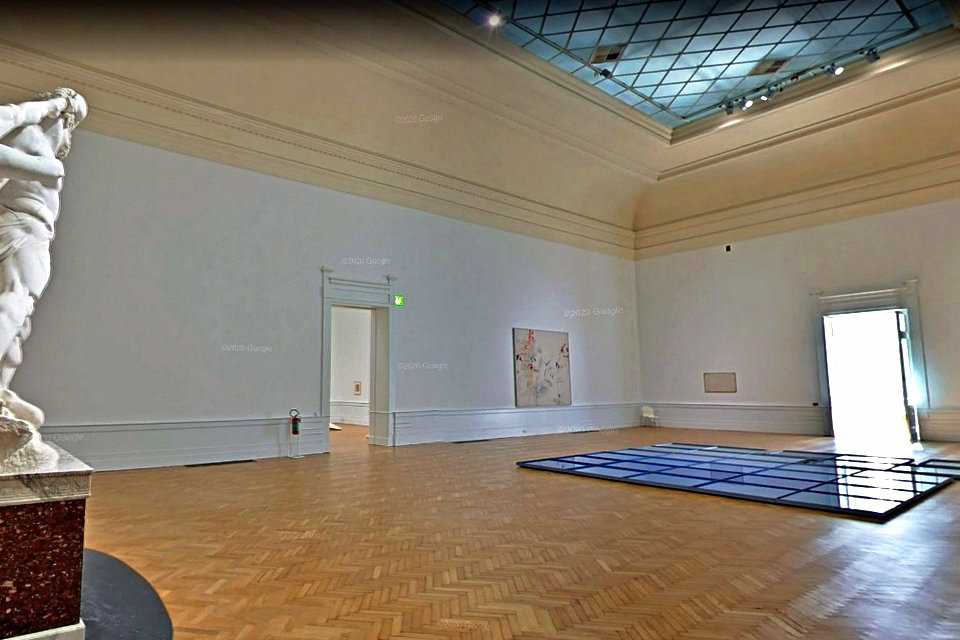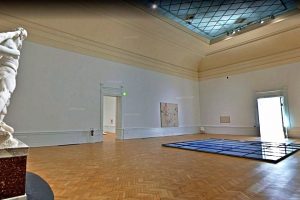National gallery of modern and contemporary art in Rome redesigned exhibition spaces, The new gallery layout was inaugurated in October 2016, based on an original project which, by reducing the number of works on display, introduces the non-chronological reading key to the main exhibition “Time is out of joint.”
Through its collections of around 20,000 works, including paintings, drawings, sculptures, and installations, the Galleria Nazionale d’Arte Moderna e Contemporanea offers a rich portrayal of Italian art culture, from the 1800s to the present day.
The current layout of the collections, designed around the theme of time, breaks away from the usual chronological path and branches off into simultaneous journeys in which works of art are placed next to each other for harmony, contrast, references, and quotations.
The building itself, designed by Cesare Bazzani in 1911, displays a critical part in this reinterpretation, creating a dialog between the present and the past. A quasi-archaeological method has been used to restore it to its former glory, all the while maintaining an immediate relationship to the present.
Room 1
Hall of Hercules
The hall is dedicated to the period of transition between neoclassicism and romanticism, between the end of the eighteenth century and the beginning of the nineteenth century.
Room 2
Hall of Psyche
The room presents the composite and international panorama of Rome in the early nineteenth century (“Roman internationalism”). It is so called for the presence, in the center of it, of the statue of:
Pietro Tenerani, Psyche passed out, 1822, marble. The statue well represents the purist style, an Italian artistic movement that arose around 1833 in the wake of the Nazarenes. Referring to an ethical conception of art, Purism recognized the primitives from Cimabue to the first Raphael as models. Important exponents of purism were in addition to Tenerani, the painter and writer Antonio Bianchini (who drafted the purism manifesto in 1849), Friedrich Overbeck, Tommaso Minardi, Augusto Mussini and others.
Room 3
Hall of Sappho
The tuscan schools.
The room is dedicated to the Tuscan painting of the first part of the nineteenth century, characterized by the presence of the Macchiaiolo movement, perhaps the most important and original Italian artistic movement of that century. The movement was based on the principle that the vision of reality is nothing more than a set of colored spots, more or less intense due to the effect of light and that the painter’s task was not to portray things as they are known to be, but to make the optical impression in the most direct way. The Michelangelo coffee (in via Larga, today Cavour; a plaque reminds him) in Florence was a meeting place for the Macchiaioli, while Pergentina (just outside Florence, along the Affrico stream) and Castiglioncello (on the coast, not far from Livorno) were the favorite places for painting. The most important and justly famous painter was Giovanni Fattori (Livorno 1825 – Florence 1908), Telemaco Signorini was the brain of the movement, Adriano Cecioni and Nino Costa were the theorists. They were known at the Florence national exhibition of 1861. Their best period was from 1855 to 1865.
Room 4
Hall of Jenner
Northern schools piedmontese and lombardo – veneta.
The painting of northern Italy of those years is characterized by the presence of the Scapigliati that can be seen above all in Giovanni Carnovali, called the Piccio. Piccio is the author of a painting played on transparencies and glazes. The Scapigliati are characterized by the dissolving of the shape in the color by forcing the blurring of the contours and the use of discontinuous and bright brush strokes, to these Tranquillo Cremona gives a pathetic and sensual characterization.
The scapigliatura was a literary and artistic movement that developed in Lombardy between 1860 and 1900. Top exponents were Emilio Praga and Arrigo Boito. From: Universale Garzanti.
Room 5
Morelli Room
The room is entirely dedicated to Domenico Morelli. In the seventies and eighties of the nineteenth century Domenico Morelli and Filippo Palizzi are the central figures of the Neapolitan and southern artistic panorama. Morelli (Naples 1826 – 1901) developed a realist style based on the pre-eminence of color over academic design, he tried to adapt his painting to content that is still romantic, literary, religious, historical and symbolist. In 1905 the Gallery purchased all that remained in the studio after the author’s death, paintings, sketches, watercolors and a large number of drawings. In the years in which Palma Bucarelli was superintendent, two rooms were dedicated to the painter. From: Encyclopedia of Art, 2002 Garzanti.
Domenico Morelli, Tasso reads the Gerusalemme Liberata a Eleonora d’Este, 1865. “One of the most famous paintings of nineteenth-century Italian painting. It is the scene of a melodrama, a similarity can be established with Verdi’s music”… as Toma’s painting is intimate and silent, so much so that Domenico Morelli’s is showy, grandiloquent and sometimes rhetorical “From: Palma Bucarelli, The National Gallery of Modern Art, 1973 State Polygraphic Institute.
It is the main painting of the room, you can see it from the hall of Hercules, thus placing itself in dialogue with the great works of historical romanticism that characterize that hall. From: Colombo – Lafranconi, Guide to the National Gallery of Modern Art, 2004 Electa. It is said that Tasso was secretly in love with Eleonora d’Este and his two companions who were also called Eleonora. From audio guide available in the Gallery in 2008.
Room 6
Cleopatra room
Southern Schools
This room is dedicated to the artists who were born, trained and operated in Naples or Southern Italy. It takes its name from the marble of:
Room 7
Palizzi room
The palizzi and the landscape painting in naples.
This room as well as the previous two is dedicated to painting in Naples and Southern Italy, it must be taken into account that Naples was at the end of the eighteenth century one of the largest European cities. The room also testifies to the presence of foreign painters in Naples and the possibility of international opening enjoyed by the painters who operated in that city.
The four Palizzi brothers came from Abruzzo to Naples to study at the Academy where they followed the courses taught by Smargiassi, one of the painters of the Posillipo school. With them, Italian painting made contact with the French and precisely with the school called Fontainebleau or Barbizon, from the place where they met to paint outdoors outside the academies. The credit is due to the older Giuseppe who, who went to Paris in 1844, remained there all his life. Filippo, to whom almost all of the paintings in the room belong, is by far the best known and most important, both for the quality of the work and for the influence it had in the affirmation of the realistic current. Palizzi’s work develops, in a Neapolitan environment, in antithesis to that of Morelli, author of a history painting and supporter of an ideal that transcends reality. In 1892 the Gallery received the donation of 300 paintings and studies by Filippo Palizzi. It is the first major donation in its history.
National gallery of modern and contemporary art in Rome
The National Gallery of Modern and Contemporary Art, also known as La Galleria Nazionale, is an art gallery in Rome, Italy. It was founded in 1883 on the initiative of the then Minister Guido Baccelli and is dedicated to modern and contemporary art.
It houses the most complete collection dedicated to Italian and foreign art from the 19th century to today. Among paintings, drawings, sculptures and installations, the almost 20,000 works in the collection are an expression of the main artistic currents of the last two centuries, from neoclassicism to impressionism, from divisionism to the historical avant-gardes of the early twentieth century, from futurism and surrealism, to the most conspicuous nucleus of works of Italian art between the 1920s and 1940s, from the twentieth century movement to the so-called Roman school.
The National Gallery of Modern and Contemporary Art keeps the complete collection of international and Italian art from the XIX to the XXI century, composed of 20.000 artworks, including paintings, drawings, sculptures and installations and it represents the major artistic movements from the last two centuries. From Neoclassicism to Impressionism, Divisionism and Historical avant-gardes of the early twentieth century, Futurism, Surrealism, the most remarkable group of works from the ’20s to the’ 40s, from the Novecento’s movement to the so-called Scuola Romana, from Pop Art to Arte Povera, contemporary art and artists from our time, and more are represented and showcased in La Galleria Nazionale’s collection and space.
The new gallery layout was inaugurated in October 2016, based on an original project which, by reducing the number of works on display, introduces the non-chronological reading key to the main exhibition ” Time is out of joint.” In addition to the new layout of the rooms, the access area to services, called the “welcome area”, the library and the Sala delle Colonne are redefined. While retaining the institutional name of the National Gallery of Modern and Contemporary Art, the gallery takes on a new name in its communication, “The National Gallery.”





